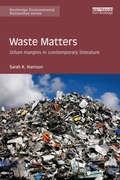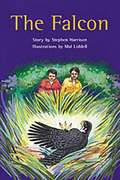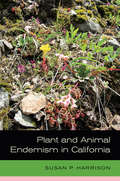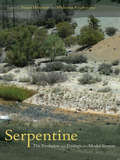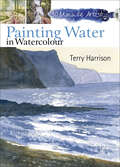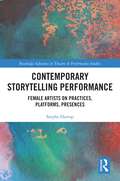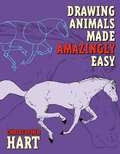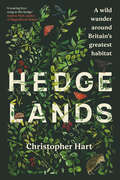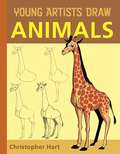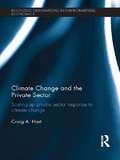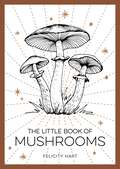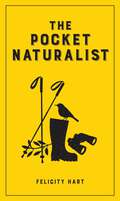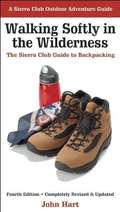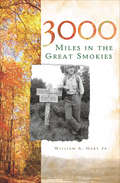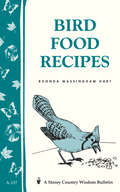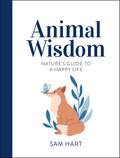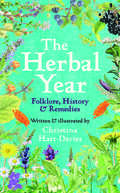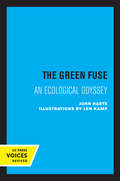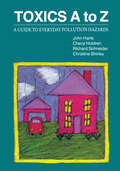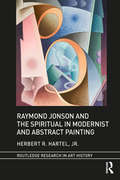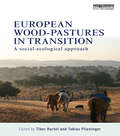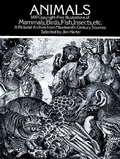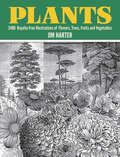- Table View
- List View
Waste Matters: Urban margins in contemporary literature (Routledge Environmental Humanities)
by Sarah K. HarrisonHow do those pushed to the margins survive in contemporary cities? What role do they play in today’s increasingly complex urban ecosystems? Faced with stark disparities in human and environmental wellbeing, what form might more equitable cities take? Waste Matters argues that contemporary literature and film offer an insightful and timely response to these questions through their formal and thematic revaluation of urban waste. In their creation of a new urban imaginary which centres on discarded things, degraded places and devalued people, authors and artists such as Patrick Chamoiseau, Chris Abani, Dinaw Mengestu, Suketu Mehta and Vik Muniz suggest opportunities for an inclusive urban politics that demands systematic analysis. Waste Matters assesses the utopian promise and pragmatic limitations of their as yet under-examined work in light of today’s pressing urban challenges. This book will be of great interest to scholars and students of English Literature, Postcolonial Studies, Urban Studies, Environmental Humanities and Film Studies.
Falcon (Rigby PM Chapter Books Emerald Levels 25-26, Fountas & Pinnell Select Collections Grade 3 Level P)
by Stephen HarrisonCarlos and Ricky arrive at a campsite with their father, where they discover a large injured bird. Dad identifies it as a falcon and he calls a nearby rescue center. Max and Lisa, from Raptor Center, put the falcon in a cage and take it back with them. The falcon does well and Max suggests the boys come to watch the release of the falcon in a few weeks. Later, the boys and their parents go to the place where the bird will be released. Their father tells them they should feel proud about helping to save the falcon, which flies off into the distance.
Plant and Animal Endemism in California
by Susan P. HarrisonCalifornia is globally renowned for its biological diversity, including its wealth of unique, or endemic, species. Many reasons have been cited to explain this abundance: the complex geology and topography of its landscape, the special powers of its Mediterranean-type climate, and the historic and modern barriers to the wider dispersal of its flora and fauna. Plant and Animal Endemism in California compiles and synthesizes a wealth of data on this singular subject, providing new and updated lists of native species, comparing patterns and causes of both plant and animal endemism, and interrogating the classic explanations proposed for the state's special significance in light of new molecular evidence. Susan Harrison also offers a summary of the innovative tools that have been developed and used in California to conserve and protect this stunning and imperiled diversity.
Serpentine: The Evolution and Ecology of a Model System
by Susan Harrison Nishanta RajakarunaSerpentine soils have long fascinated biologists for the specialized floras they support and the challenges they pose to plant survival and growth. This volume focuses on what scientists have learned about major questions in earth history, evolution, ecology, conservation, and restoration from the study of serpentine areas, especially in California. Results from molecular studies offer insight into evolutionary patterns, while new ecological research examines both species and communities. Serpentine highlights research whose breadth provides context and fresh insights into the evolution and ecology of stressful environments.
Painting Water in Watercolour (30 Minute Artist)
by Terry Harrison“From beach scenes to ponds, rivers to seas, puddles and streams, Terry shows how to paint water in all its beautiful painterly effects.” —Karen Platt, yarnsandfabrics.co.ukAll watercolour landscape artists need to know how to paint water, and in this book Terry Harrison excels in demystifying the painting process. Here he shares his expert advice and no-nonsense tips and techniques for producing quick, effective paintings of water. There are two or three-step exercises for painting water in all its varied moods and situations, including ripples, reflections, puddles, streams, breaking waves, choppy water, surf, bridges, riverbeds, boats, and much more. There are then ten step-by-step demonstrations that can be produced in half an hour: a misty lake, track with puddles, ford, waterfall, lazy river, stormy sea, cliffs, fisherman, sunset estuary and fishing boat.Essential painting skills conveyed through quick, lively studiesExpert art tuition from a renowned artist, for beginners, the busy artist, or those wanting to loosen up their painting styleNumerous quick exercises and ten step-by-step demonstrations in a handy, affordable ebook format“Terry demonstrates twenty-three basic exercises to build your confidence with the subject from rippled reflections to crashing waves, fast-flowing streams to sun setting on the sea.” —The Leisure Painter
Contemporary Storytelling Performance: Female Artists on Practices, Platforms, Presences (Routledge Advances in Theatre & Performance Studies)
by Stephe HarropThis book focuses on a rising generation of female storytellers, analysing their innovation in interdisciplinary collaboration, and their creation of new multimedia platforms for story-led performance. It draws on an unprecedented series of in-depth interviews with artists including Jo Blake, Xanthe Gresham-Knight, Mara Menzies, Clare Murphy, Debs Newbold, Rachel Rose Reid, Sarah Liisa Wilkinson, and Vanessa Woolf, while Sally Pomme Clayton’s reflections on her extraordinary four-decade career provide long-term context for these cutting-edge conversations. Blending ethnographic research and performance analysis, the book documents the working lives of professional storytelling artists. It sheds light on the practices, values, aspirations, and achievements of a generation actively re-defining storytelling as a contemporary performance practice, taking on topics from ecology and maternity to griefwork and neuroscience, while working collaboratively with diverse creative partners to generate new, inclusive presences for a traditionally-inspired artform. This book will be of great interest to students, scholars, and practitioners in drama, theatre, performance, creative writing, education, and media.
Water Histories and Spatial Archaeology
by Michael J. HarrowerThis book offers a new interpretation of the spatial-political-environmental dynamics of water and irrigation in long-term histories of arid regions. It compares ancient Southwest Arabia (3500 BC–AD 600) with the American West (2000 BC–AD 1950) in global context to illustrate similarities and differences among environmental, cultural, political, and religious dynamics of water. It combines archaeological exploration and field studies of farming in Yemen with social theory and spatial technologies, including satellite imagery, Global Positioning System (GPS), and Geographic Information Systems (GIS) mapping. In both ancient Yemen and the American West, agricultural production focused not where rain-fed agriculture was possible, but in hyper-arid areas where massive state-constructed irrigation schemes politically and ideologically validated state sovereignty. While shaped by profound differences and contingencies, ancient Yemen and the American West are mutually informative in clarifying human geographies of water that are important to understandings of America, Arabia, and contemporary conflicts between civilizations deemed East and West.
Drawing Animals Made Amazingly Easy (Made Amazingly Easy Series)
by Christopher HartChristopher Hart, America's best-selling author of art instruction books, tosses all that aside to make drawing animals truly amazingly easy, by simplifying animal anatomy so that artists can get the poses they really want. What does that animal look like as it moves, bends, twists, jumps, runs? Simplified skeletons and an innovative new approach show how to look at an animal as a strangely built human with an odd posture--allowing the artist to draw animals by identifying with them. Hart's step-by-step instructions and clear text mean true-to-life results every time, whether the subjects are dogs, cats, horses, deer, lions, tigers, elephants, monkeys, bears, birds, pigs, goats, giraffes, or kangaroos.
Hedgelands [US Edition]: A wild wander around Britain’s greatest habitat
by Christopher HartOn this joyous journey around the wild edges of Britain, celebrated author Christopher Hart takes us through the life, ecology and history of the humble countryside hedge and how it is inextricably woven into our language, landscape and culture. Hedges – or hedgerows – have long been an integral part of the British landscape. An ancient, human-made boundary, hedgerows have become a critically important haven for wildlife and are now being recognised as one of the greatest ‘edge’ habitats on Earth. Britain boasts 400,000 kilometres of hedgerows, but has lost 50 per cent of them since the Second World War and their slow deterioration today is becoming a huge threat to the ecosystem. In Hedgelands, Christopher Hart shares the history of the hedge, highlighting the hawthorn and hazel of ancient hedgerows, and reveals its abundance of wildlife, from the elusive dunnock to the iconic nightingale, the industrious hedgehog to the miniscule harvest mouse. He demonstrates how this true environmental hero and powerful climate ally can help rebuild species-rich, resilient havens for birds, mammals and insects. Hedges play a vital role in mature woodland, grassland and even wetland, all of which can offer us much-needed ecological diversity and carbon sequestration. Through rewilding a patch of land in southwest England, Christopher shows us how easy, joyful and rewarding it is to restore even the smallest stretch of hedge. Whether you live in the country or the city, Hedgelands shares how simple actions can make a huge difference to the future of our precious hedges – and environment. “What’s good for us is good for nature, and what’s good for nature is good for us. And nowhere is this more true than in the bustling, flourishing, flowering, fruiting and altogether glorious native British hedge.”—Christopher Hart
Young Artists Draw Animals (Christopher Hart's Young Artists Draw)
by Christopher HartDo You Love Animals? Now you can learn to draw them on your own! This book has everything that the animal-loving artist needs! To get started, you'll learn how to draw animals' basic head and body shapes . . . and that's just the beginning! Over 100 different animals from around the world--from playful dogs, cuddly cats, and hungry bears to clever monkeys, giant giraffes, and ferocious sharks--are broken down into easy-to-follow steps so that you can start drawing all of your favorite animals right away.Also available as an eBook
Climate Change and the Private Sector: Scaling Up Private Sector Response to Climate Change (Routledge Explorations in Environmental Economics #40)
by Craig A. HartClimate Change and the Private Sector explores the challenges of transforming our energy infrastructure to become carbon neutral and adapting to climate change in the twenty-first century. It examines the critical role that the private sector must play in these challenges. To transform the global energy complex to be carbon neutral within a time frame designed to prevent irreparable damage to the environment presents unprecedented challenges. The private sector must deploy financial, material, and engineering resources on a scale never before undertaken — with government providing leadership, removing barriers and supporting industry efforts through policies that mobilize markets to achieve environmental objectives. A key element of supporting private sector initiative to address climate change is policies that help form and sustain markets that supply, finance and generate demand for the technologies necessary to transform our energy infrastructure. The characteristics and examples of these policies are explored in detail. Companies that respond to these challenges both by mitigating greenhouse gases and adapting to climate change will enhance their own competitiveness and contribute to society in the process. Companies that embrace the challenge to decarbonize their manufacturing operations, whether in response to regulation (or the threat of regulation) or market opportunities, invariably discover ways to improve their operations in the process that could potentially enhance their ability to produce better products, more efficiently. The book explores examples of companies that have redesigned their products and manufacturing processes, and in doing so transformed themselves and reshaped their industries. As in the case of companies mitigating greenhouse gas emissions, companies that lead their industries in adapting their own operations to a changing physical environment are more likely to ensure their resilience in a changing business environment. This book provides business, policy and academic audiences with an in-depth exploration of the subject, and a practical guide to action.
The Little Book of Mushrooms: An Introduction to the Wonderful World of Mushrooms
by Felicity HartDiscover the fascinating world of mushrooms with this beautiful pocket guide, featuring trivia, history, identification tips, delicious recipes and moreOne of nature’s most extraordinary organisms can be found right under your feet: the mushroom. For thousands of years these fungi have intrigued humankind, providing food, inspiring folklore and proving to be both poison and cure.The Little Book of Mushrooms will allow you to uncover this mysterious kingdom for yourself. Learn the difference between a giant puffball and a scarlet elf cup and discover how mushrooms and the fungal network help plant life to communicate. You will also find:Fascinating facts about the fungi kingdomMushroom folklore from around the worldA beginner’s guide to identifying common wild mushroomsA collection of delicious mushroom-based recipes Mushrooms are vital to life on earth, and this book will be your guide to these spectacular organisms that have influenced our past and could shape our future.
The Pocket Naturalist
by Felicity HartFind yourself enthralled by the great outdoors with the collected wisdom inside this handy book. Packed with countryside facts and tips for identifying flora and fauna, this is the perfect companion for any nature lover. Whether you’re seeking knowledge or encouragement, The Pocket Naturalist will deepen your delight in the natural world.
The Pocket Naturalist
by Felicity HartFind yourself enthralled by the great outdoors with the collected wisdom inside this handy book. Packed with countryside facts and tips for identifying flora and fauna, this is the perfect companion for any nature lover. Whether you’re seeking knowledge or encouragement, The Pocket Naturalist will deepen your delight in the natural world.
Walking Softly in the Wilderness: The Sierra Club Guide to Backpacking (4th edition)
by John HartThe ultimate manual for wilderness travelers and campers, "Walking Softly in the Wilderness" is the groundbreaking guide that first taught backpackers how to enjoy a genuine wilderness experience that leaves nature undisturbed. In recent years backpacking gear and practices have undergone many changes, and all are noted and expertly evaluated by author John Hart in this new edition. Covering the latest in "ultralight" gear choices, as well as down-loadable maps, portable GPS devices, and the world of online information, Hart is a sure-footed guide to this changing scene.
3000 Miles in the Great Smokies
by William A. Hart Jr.A hiking memoir by &“a man whose soul is held in thrall by remote places in the Smokies where . . . rising trout and fog-laden valleys rule supreme&” (Jim Casada, The Literature of Hiking in the Smokies). Bill Hart has hiked, camped and fished in the Great Smoky Mountains National Park for more than forty years. In over three thousand miles of walking, he has recorded experiences and impressions that will delight readers of all ages. Whether exploring some of the most remote sections of the Smokies, angling for trout, meeting mountain folk, or marveling at the flora and fauna around him, Bill has a gift for heartfelt storytelling and a wealth of knowledge to share about the park. Join him for an unforgettable journey through a beloved national treasure. Includes photos &“[A] collection of essays and journal entries of over 40 years of hiking, camping and exploring in the Great Smoky Mountain National Park.&” —Go Knoxville &“A compilation of thoughts and reminiscences of his wonderful days and nights there.&” —Smoky Scout&’s Hiking Adventures
Bird Food Recipes: Storey Country Wisdom Bulletin A-137 (Storey Country Wisdom Bulletin Ser.)
by Rhonda Massingham HartSince 1973, Storey's Country Wisdom Bulletins have offered practical, hands-on instructions designed to help readers master dozens of country living skills quickly and easily. There are now more than 170 titles in this series, and their remarkable popularity reflects the common desire of country and city dwellers alike to cultivate personal independence in everyday life.
Animal Wisdom: Nature's Guide to a Happy Life
by Sam HartSelf-care gone wild Slow down like a sloth, stretch like a cat, breathe deep like a whale and have the confidence of a lion. When life gets you down, lift your spirits with these tiny tips and helpful hints from our friends in the animal kingdom.
The Herbal Year: Folklore, History and Remedies
by Christina Hart-DaviesAn enchanting, beautifully illustrated guide to seasonal plants—showing the long history of herbal remedies and their uses today“[A] charming almanac. . . . Hart-Davies, a writer and botanical illustrator whose watercolors enliven her book, . . . offers a lively combination of folk history and modern science; they overlap in intriguing ways.”—Priscilla M. Jensen, Wall Street Journal From sweet violets in spring to rosemary in winter, via marigolds, sage, elderberries, and hops, every season has its own bounty of herbs and plants. Christina Hart-Davies presents a delightful guide to common plants as they appear throughout the year. Drawing on writers, storytellers, and poets from across the centuries, she examines the long history of herbal remedies. She shows how plants have been used for healing and unearths the stories and beliefs that surround them—including simple recipes for use at home. Fully illustrated with exquisitely detailed watercolours, this is an inspirational guide to exploring our age-old relationship with plants. Readers will discover the hidden secrets of the plants that surround us and, through this, will be able to reconnect with our place in nature. We have relied on plants throughout our history. We still do, and, with luck, we always will.
The Green Fuse: An Ecological Odyssey
by John HarteA widely respected ecological scientist and activist draws on the poet's image and his own environmental research to demonstrate the many interconnections among the world's ecosystems. John Harte takes us from Alaskan salmon runs and the Florida everglades to South Pacific coral reefs and the bleak Tibetan plateau. The result is that rare book that bridges the cultures of science and art. Lyrical, vivid portraits of natural wonders and the threats to them are combined with precise scientific accounts of natural processes and their disturbances. The Green Fuse will show nonscientists the fascination of ecological detective work and renew scientists' love for the beauty of the world under their microscopes. Harte's stories illuminate, without sermonizing, the damage to natural systems brought about by technological hubris and calculated political ruthlessness. "The green fuse" symbolizes the basic unity behind natural diversity. But a fuse may also be the weak link in an overloaded system or the slow burning wick on an ecological bomb. As The Green Fuse reminds us, the energies that created human liberation from nature can also be those that lead to the human destruction of nature. This title is part of UC Press's Voices Revived program, which commemorates University of California Press’s mission to seek out and cultivate the brightest minds and give them voice, reach, and impact. Drawing on a backlist dating to 1893, Voices Revived makes high-quality, peer-reviewed scholarship accessible once again using print-on-demand technology. This title was originally published in 1993.
Toxics A to Z: A Guide to Everyday Pollution Hazards
by John Harte Cheryl Holdren Richard Schneider Christine ShirleyToxics A to Z features and alphabetical listing of over 100 toxics, identifying . . .What they areHow they are measuredWhere they are foundThe symptoms of exposureWhat their known risks areHow we can lessen or avoid those risksAn easy-to-use Cross-Reference Guide to help readers identify toxics in 18 major groups, including indoor and outdoor air pollutants, household items, and lawn and garden productsA glossary of terms, explanation of abbreviations, and listing of sources for further help and information
Raymond Jonson and the Spiritual in Modernist and Abstract Painting (Routledge Research in Art History)
by Herbert R. Hartel, Jr.This is the most thorough and detailed monograph on the artwork of Raymond Jonson. He is one of many artists of the first half of the twentieth-century who demonstrate the richness and diversity of an under-appreciated period in the history of American art. Visualizing the spiritual was one of the fundamental goals of early abstract painting in the years before and during World War I. Artists turned to alternative spirituality, the occult, and mysticism, believing that the pure use of line, shape, color, light and texture could convey spiritual insight. Jonson was steadfastly dedicated to this goal for most of his career and he always believed that modernist and abstract styles were the most effective and compelling means of achieving it.
European Wood-pastures in Transition: A Social-ecological Approach
by Tibor Hartel Tobias PlieningerWood-pastures are important elements of European cultural identity and have an exceptional ecological value, yet they are in decline all over Europe. The structure of wood-pastures is strongly influenced by grazing and multiple other land uses and by local and regional environmental conditions. This book examines the diverse expressions of wood-pastures across Europe. It provides a new perspective, using a social-ecological framework to explore social and ecological values, governing institutions, threats and conservation approaches. It explores the major drivers of decline, which are shown to be related to accelerated cultural, institutional and developmental changes occurring across Europe over the past century. Case studies are included from North-Western, Southern, and Eastern Europe. Written by renowned scholars and conservationists, the book contributes to developing better, locally adapted conservation policies and management approaches for wood-pastures.
Animals: 1,419 Copyright-Free Illustrations of Mammals, Birds, Fish, Insects, etc (Dover Pictorial Archive)
by Jim HarterSelected for its visual impact and ease of use, this outstanding collection of wood engravings presents over 1,000 species of animals in extremely lifelike poses. Includes many different versions of familiar mammals, birds, reptiles, amphibians, fish, insects, and other invertebrates such as spiders, crabs, squid, earthworms, and more. Captions provide modern common-name identifications.
Plants: 2,400 Royalty-Free Illustrations of Flowers, Trees, Fruits and Vegetables
by Jim HarterHundreds of plant species -- from lilies, lichens, and palms to mushrooms, mosses, and maples -- supplemented by appendices on edible plants, medicinal herbs, and plants used in decoration and in graphic design. Indispensable source of inspiration and royalty-free graphics for designers and artists; a captivating compendium for botanists, gardeners, and collectors of old engravings.
